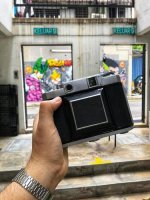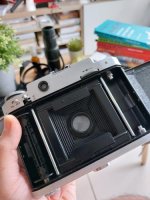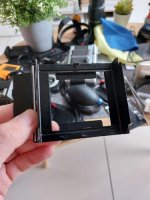r_torc
Newbie
I have tried getting help in other forums, to apparently no avail until I found this goldmine of 120 RF Folders! I hope you guys might be able to help me out.
I got this amazing Mamiya Six V, it's in very, very good condition and even the slow speeds are hitting the mark exactly, which is a pleasant surprise!
In case it matters, it has a Seikosha-Rapid shutter and a D. Zuiko F.C. 75mm, F3.5 lens.
My issue is just with the focusing. The focusing scale doesn't match at all the focus on the film plane so 5 meters on disc scale is roughly focusing on something that is about 2.3 meters or so in real life. If I focus on infinity the images that do match at close distances don't match at infinity. Seems as though I can either have it focus correctly at close range or focus correctly near infinity but not both. Ideally, I'd like to be able to match close enough the distance scale since it would help for some street photography and zone focusing for fast shots.
Is there a "proper method" (steps that need to be in order) to adjust the focus with these cameras? I would think perhaps the lens could use some spacers/shims? I checked inside the film chamber and everything seems fine. The camera is absolutely pristine, nothing is missing and it has no dings, any signs of abuse, rust or any mold.
When I move the focusing wheel all the way either direction, the film plane moves the whole range of motion in both directions so I don't think there's anything hindering the motion of that either.
At the moment, it appears as though I can take photos at close distances and be reasonably in focus, but the scale still doesn't match and that kinda bothers me... (I did, to the best of my abilities, make the RF patch match what the lens is REALLY doing, ignoring the distance scale) :bang:
Any help would be greatly appreciated. I'd love to get this camera working correctly, everything on it is pristine condition and I'd love to get many more years of use on it! It's so compact that I find myself reaching out for it more often than any of my other cameras, so if I could just fix that it would be incredible!
EDIT:
So I did this and thanks to @Sarcophilus Harrisii for his detailed response:
I entirely ignored what the distance scale disc said and focused entirely on what the actual lens was seeing, as it was pointed out as well.
I put the camera on a tripod, I locked the bulb mode with a cable release and focused to infinity. To my pleasant surprise, at infinity, buildings around 7 km away from my house were sharp (reasonably at the very least since I have a rather coarse ground glass so it takes some resolution away). This confirmed that in fact my focus was correct at infinity as far as the lens and the scale were concerned.
Then I turned my attention to check my RF patch. I took the lens back to infinity and checked once again to ensure I was indeed right in my initial check, then I aligned the RF patch to match infinity in the rangefinder.
The results are that it APPEARS to be in focus correctly at all distances now and the RF patch is aligned properly to all the the distances. The distance scale is a little off, but totally within an acceptable tolerance. The disc actually is in feet, not meters, so there's that. I took my most reliable cameras and focused on a tripod on the same subject and they all were more or less on the same numerical value, which is a relief to me since all the other cameras are tack sharp.
I will put a test roll and give it a whirl once again.
I appreciate all of your responses and your time, I will edit my original post as it appears that I have managed to adequately calibrate the camera and the RF.

I got this amazing Mamiya Six V, it's in very, very good condition and even the slow speeds are hitting the mark exactly, which is a pleasant surprise!
In case it matters, it has a Seikosha-Rapid shutter and a D. Zuiko F.C. 75mm, F3.5 lens.
My issue is just with the focusing. The focusing scale doesn't match at all the focus on the film plane so 5 meters on disc scale is roughly focusing on something that is about 2.3 meters or so in real life. If I focus on infinity the images that do match at close distances don't match at infinity. Seems as though I can either have it focus correctly at close range or focus correctly near infinity but not both. Ideally, I'd like to be able to match close enough the distance scale since it would help for some street photography and zone focusing for fast shots.
Is there a "proper method" (steps that need to be in order) to adjust the focus with these cameras? I would think perhaps the lens could use some spacers/shims? I checked inside the film chamber and everything seems fine. The camera is absolutely pristine, nothing is missing and it has no dings, any signs of abuse, rust or any mold.
When I move the focusing wheel all the way either direction, the film plane moves the whole range of motion in both directions so I don't think there's anything hindering the motion of that either.
At the moment, it appears as though I can take photos at close distances and be reasonably in focus, but the scale still doesn't match and that kinda bothers me... (I did, to the best of my abilities, make the RF patch match what the lens is REALLY doing, ignoring the distance scale) :bang:
Any help would be greatly appreciated. I'd love to get this camera working correctly, everything on it is pristine condition and I'd love to get many more years of use on it! It's so compact that I find myself reaching out for it more often than any of my other cameras, so if I could just fix that it would be incredible!
EDIT:
So I did this and thanks to @Sarcophilus Harrisii for his detailed response:
I entirely ignored what the distance scale disc said and focused entirely on what the actual lens was seeing, as it was pointed out as well.
I put the camera on a tripod, I locked the bulb mode with a cable release and focused to infinity. To my pleasant surprise, at infinity, buildings around 7 km away from my house were sharp (reasonably at the very least since I have a rather coarse ground glass so it takes some resolution away). This confirmed that in fact my focus was correct at infinity as far as the lens and the scale were concerned.
Then I turned my attention to check my RF patch. I took the lens back to infinity and checked once again to ensure I was indeed right in my initial check, then I aligned the RF patch to match infinity in the rangefinder.
The results are that it APPEARS to be in focus correctly at all distances now and the RF patch is aligned properly to all the the distances. The distance scale is a little off, but totally within an acceptable tolerance. The disc actually is in feet, not meters, so there's that. I took my most reliable cameras and focused on a tripod on the same subject and they all were more or less on the same numerical value, which is a relief to me since all the other cameras are tack sharp.
I will put a test roll and give it a whirl once again.
I appreciate all of your responses and your time, I will edit my original post as it appears that I have managed to adequately calibrate the camera and the RF.
Attachments
Last edited:




